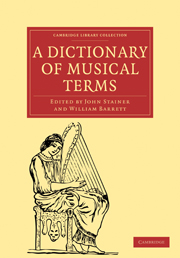F
Published online by Cambridge University Press: 10 November 2010
Summary
F.(1) The note called parhypate in the Greater Perfect system of the Greeks. The letter-name of Trite in the upper tetrachord.
(2) The first note of the Eolian mode, or church, scale, commencing four notes above the hypo-Eolian. [Greek music]
(3) The note called “Fa ut” in the hexachord system. [Notation.]
(4) The key-note of the major scale requiring one flat in the signature; and the keynote of the minor scale related to A flat.
Fa. The syllable used in solmisation for F. [Aretinian Syllables.]
Fa bemol (Fr.) F flat.
Fablier (Provençal). [Troubadour.]
Faburden, Falsobordone (It.) Fauxbourdon (Fr.) One of the early systems of harmonising a given portion of plain-song, or a canto fermo. As the word implies, to faburden signified originally to hold a drone (bordonizare). It was afterwards used as a term for a sort of harmony consisting of thirds and sixths added to a canto ferrho. It will be remembered that the organum was similar in construction, being only note against note, but consisted of fourths, fifths, and octaves. [See Descant.] But when counterpoint had superseded both diaphony and, descant, the term faburden still was retained, and applied to certain species of counterpoint, sometimes (but not always) note against note.
- Type
- Chapter
- Information
- A Dictionary of Musical Terms , pp. 163 - 192Publisher: Cambridge University PressPrint publication year: 2009First published in: 1876



